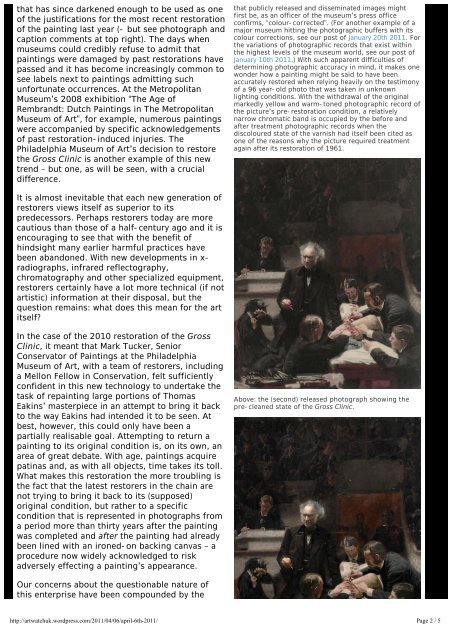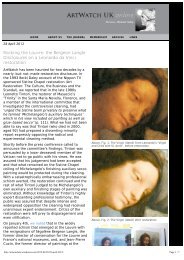Thomas Eakins' The Gross Clinic â A suitable Case for ... - Artwatch
Thomas Eakins' The Gross Clinic â A suitable Case for ... - Artwatch
Thomas Eakins' The Gross Clinic â A suitable Case for ... - Artwatch
- No tags were found...
You also want an ePaper? Increase the reach of your titles
YUMPU automatically turns print PDFs into web optimized ePapers that Google loves.
that has since darkened enough to be used as oneof the justifications <strong>for</strong> the most recent restorationof the painting last year (- but see photograph andcaption comments at top right). <strong>The</strong> days whenmuseums could credibly refuse to admit thatpaintings were damaged by past restorations havepassed and it has become increasingly common tosee labels next to paintings admitting suchun<strong>for</strong>tunate occurrences. At the MetropolitanMuseum’s 2008 exhibition “<strong>The</strong> Age ofRembrandt: Dutch Paintings in <strong>The</strong> MetropolitanMuseum of Art”, <strong>for</strong> example, numerous paintingswere accompanied by specific acknowledgementsof past restoration-induced injuries. <strong>The</strong>Philadelphia Museum of Art’s decision to restorethe <strong>Gross</strong> <strong>Clinic</strong> is another example of this newtrend – but one, as will be seen, with a crucialdifference.that publicly released and disseminated images mightfirst be, as an officer of the museum’s press officeconfirms, “colour-corrected”. (For another example of amajor museum hitting the photographic buffers with itscolour corrections, see our post of January 20th 2011. Forthe variations of photographic records that exist withinthe highest levels of the museum world, see our post ofJanuary 10th 2011.) With such apparent difficulties ofdetermining photographic accuracy in mind, it makes onewonder how a painting might be said to have beenaccurately restored when relying heavily on the testimonyof a 96 year-old photo that was taken in unknownlighting conditions. With the withdrawal of the originalmarkedly yellow and warm-toned photographic record ofthe picture’s pre-restoration condition, a relativelynarrow chromatic band is occupied by the be<strong>for</strong>e andafter treatment photographic records when thediscoloured state of the varnish had itself been cited asone of the reasons why the picture required treatmentagain after its restoration of 1961.It is almost inevitable that each new generation ofrestorers views itself as superior to itspredecessors. Perhaps restorers today are morecautious than those of a half-century ago and it isencouraging to see that with the benefit ofhindsight many earlier harmful practices havebeen abandoned. With new developments in x-radiographs, infrared reflectography,chromatography and other specialized equipment,restorers certainly have a lot more technical (if notartistic) in<strong>for</strong>mation at their disposal, but thequestion remains: what does this mean <strong>for</strong> the artitself?In the case of the 2010 restoration of the <strong>Gross</strong><strong>Clinic</strong>, it meant that Mark Tucker, SeniorConservator of Paintings at the PhiladelphiaMuseum of Art, with a team of restorers, includinga Mellon Fellow in Conservation, felt sufficientlyconfident in this new technology to undertake thetask of repainting large portions of <strong>Thomas</strong>Eakins’ masterpiece in an attempt to bring it backto the way Eakins had intended it to be seen. Atbest, however, this could only have been apartially realisable goal. Attempting to return apainting to its original condition is, on its own, anarea of great debate. With age, paintings acquirepatinas and, as with all objects, time takes its toll.What makes this restoration the more troubling isthe fact that the latest restorers in the chain arenot trying to bring it back to its (supposed)original condition, but rather to a specificcondition that is represented in photographs froma period more than thirty years after the paintingwas completed and after the painting had alreadybeen lined with an ironed-on backing canvas – aprocedure now widely acknowledged to riskadversely effecting a painting’s appearance.Above: the (second) released photograph showing thepre-cleaned state of the <strong>Gross</strong> <strong>Clinic</strong>.Our concerns about the questionable nature ofthis enterprise have been compounded by thehttp://artwatchuk.wordpress.com/2011/04/06/april-6th-2011/ Page 2 / 5




